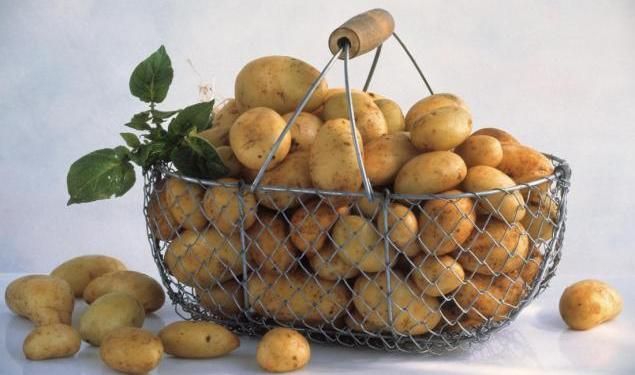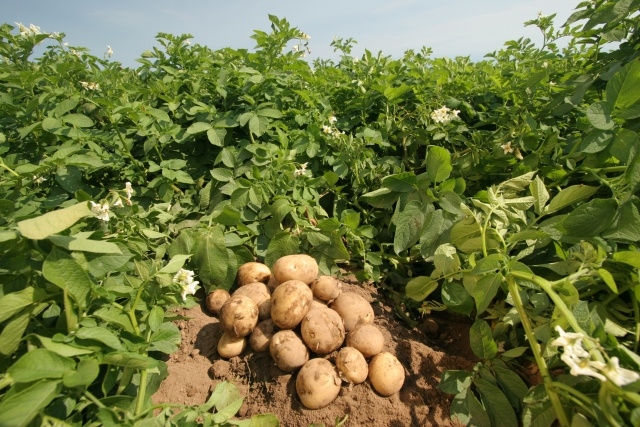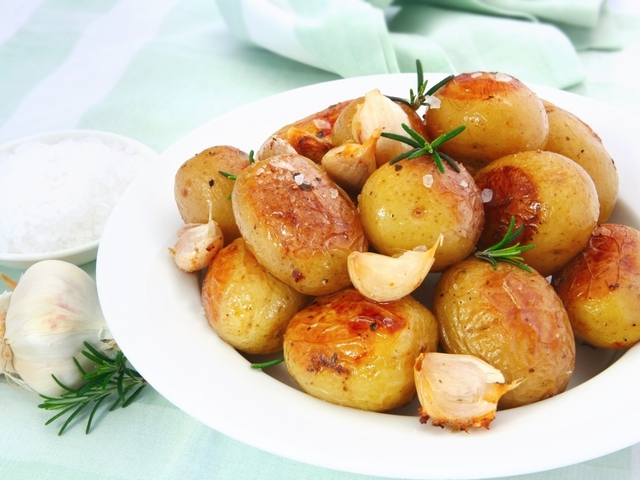Potatoes, sir?
In this article you will find not only interesting facts about the origin and use of potatoes, but also learn about the beneficial properties of this product, and how to get the most benefit from well-known potatoes.
 Origins of the Potato
Origins of the Potato
The potato, from the perennial Solanum tuberosum, is the world’s fourth largest food crop, following rice, wheat, and maize. The Inca Indians in Peru were the first to cultivate potatoes around 8,000 BC to 5,000 B.C.
In 1536 Spanish Conquistadors conquered Peru, discovered the flavors of the potato, and carried them to Europe. Before the end of the sixteenth century, families of Basque sailors began to cultivate potatoes along the Biscay coast of northern Spain. Sir Walter Raleigh introduced potatoes to Ireland in 1589 on the 40,000 acres of land near Cork. It took nearly four decades for the potato to spread to the rest of Europe.
Eventually, agriculturalists in Europe found potatoes easier to grow and cultivate than other staple crops, such as wheat and oats. Most importantly, it became known that potatoes contained most of the vitamins needed for sustenance, and they could be provided to nearly 10 people for each acre of land cultivated.
Potatoes arrived in the Colonies in 1621. The first permanent potato patches in North America were established in 1719 by Scotch-Irish immigrants. From there, the crop spread across the country.
French Fries were introduced to the U.S. when Thomas Jefferson served them in the White House during his Presidency of 1801-1809. Collinet, chef for French King Louis Phillipe (reign 1830-1848) unintentionally created soufflés (or puffed) potatoes by plunging already fried potatoes into extremely hot oil to reheat them when the King arrived late for dinner one night. To the chef’s surprise and the king’s delight, the potatoes puffed up like little balloons. In 1853 railroad magnate Commodore Cornelius Vanderbilt complained that his potatoes were cut too thick and sent them back to the kitchen at a fashionable resort in Saratoga Springs, NY. To spite his haughty guest, Chef George Crum sliced some potatoes paper thin, fried them in hot oil, salted and served them. To everyone’s surprise, Vanderbilt loved his “Saratoga Crunch Chips,” and potato chips have been popular ever since.
Did you know…
- During the Alaskan Klondike gold rush, (1897-1898) potatoes were practically worth their weight in gold. Potatoes were valued for their vitamin C. And gold, at that time, was more plentiful than nutritious foods!
- In October 1995, the potato became the first vegetable to be grown in space. NASA and the University of Wisconsin, Madison, created the technology with the goal of feeding astronauts on long space voyages, and eventually, feeding future space colonies.
The Incas had many uses for potatoes other than dinner:
- Placed raw slices on broken bones to promote healing
- Carried them to prevent rheumatism
- Ate with other foods to prevent indigestion.
- Help a toothache by carrying a potato in your pocket.
 Organic potatoes
Organic potatoes
Potatoes contain low levels of natural benzodiazepines, which act as sedatives, anticonvulsants, anxiety and muscle relaxers and as hypnotics. Perhaps this is why Western diets are so hooked on potato as a comfort food! Importantly, new research suggests that the humble potato may also play an important preventative health role.
Pesticides applied to conventional potato crops
- Root vegetables, such as potatoes, absorb whatever is in the soil. This means that chemicals (herbicides, pesticides, and fungicides) in the soil also become part of the potato too.
- There are 78 pesticides with established tolerance (residue limits for pesticides used in the U.S. or by countries exporting to the U.S.) for potatoes.
- 38 are acutely toxic creating a hazardous environment for farmworkers, 68 are linked to chronic health problems (such as cancer), 7 contaminate streams or groundwater, and 68 are poisonous to wildlife.
- Pesticides that may be applied to conventionally grown potatoes, which have been identified as acutely toxic, include: Aldicarb, Clothianidin, Methamidophos, Methyl parathion, and Propargite.
That is why it is so important to buy organic!
Storing potatoes
- Potatoes will store for several months in a cool, dry place away from light – the corner of a kitchen cupboard is ideal.
- Store potatoes loose and do not put them in the refrigerator, as the moist air will turn the potatoes’ starch to sugar.
- Avoid storing potatoes in direct contact with onions as this tends to make potatoes rot.
- Always discard potatoes with green skins. Green potatoes have been exposed to light and have developed a poisonous alkaloid in their flesh.
- Sprouted or soft potatoes are not toxic, but have virtually no nutrients.
 Preparing and eating potatoes
Preparing and eating potatoes
- Potatoes are probably the most versatile of all the root crops.
- Waxy potatoes are perfect for salads, boiling or roasting. Starchy types are great for baking and mashing.
- Trim off green areas and sprouts but leave the skins on for more nutrition.
- Wash potatoes thoroughly before eating. Scrub them with a vegetable brush to remove dirt and particles.
- Whether boiled, microwaved, fried, baked, grilled, roasted, or mashed, cooking potatoes is easy, fun, and sure to please both young and old members of the household.
- A medium-sized potato contains about half of the daily recommended intake of vitamin C. With the skin on, potatoes supply 24 per cent of the daily intake of potassium.
- To give some idea of how nutritious potatoes are, a medium-sized potato has as much vitamin C as a medium tomato and twice as much potassium as a banana.
- Colorful potatoes, particularly red- and purple-skin and -flesh potatoes, contain the highest levels of antioxidants, especially carotenoids and thocyanins.
Nutritional properties of potatoes
- A medium-sized potato contains about half of the daily recommended intake of vitamin C. With the skin on, potatoes supply 24 per cent of the daily intake of potassium.
- To give some idea of how nutritious potatoes are, a medium-sized potato has as much vitamin C as a medium tomato and twice as much potassium as a banana.
- Colorful potatoes, particularly red- and purple-skin and -flesh potatoes, contain the highest levels of antioxidants, especially carotenoids and thocyanins.
Medicinal properties of potatoes
- Human case studies have shown that lectins, such as those found in potatoes, attach to receptors on cancer cell membranes, leading to apoptosis and cytotoxicity, and inhibiting tumour growth.
- A long-term study that looked at more than 80,000 women found that eating potatoes has a number of heart health benefits.
- According to the United States Food and Drug Administration, “Foods, such as potatoes, that are good sources of potassium and low in sodium may reduce the risk of high blood pressure and stroke.”
- Potatoes also contain glycoalkaloids which reduce the production of certain cancer cells, such as those in the liver.
- Extracts from the leaves and roots have been used to treat heart disorders. Leaf extracts have antimicrobial and anti-fungal properties.

